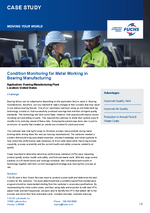Case Study - Condition Monitoring for Metal Working in Bearing Manufacturing
Challenge
Bearing failure can be catastrophic depending on the application they‘reused in. Bearing manufacturers, therefore, are very hesitant to make changes to their process that may result in premature bearing failures. One of our customers had been using an old metal working technology, soluble oil, that successfully produced bearings that met their stringent quality standards. This technology did have some flaws, however, that caused performance issues including rust and pitting on parts. This required the customer to dump their system every 6 months to try and stay ahead of these risks. Dumping the system was done also in part to avoid poor air quality that created an unsafe environment for plant personnel.
The customer was looking for ways to introduce process improvements during metal working while driving down the cost per bearing manufactured. The customer needed a solution that would bring specialized expertise, process knowledge and robust systems to help collect the performance data necessary to drive costs down while improving process capability, process availability and the current health and safety concerns related to air quality.
It was important to determine which key performance indicators (KPIs) were impacting product quality, worker health and safety, and fluid and waste costs. With two large central systems on a 6-month dump and recharge schedule, their old established soluble-oil technology together with their current management strategy was leaving their process at risk.
Solution
FUCHS sent in their Smart Services team to conduct a plant audit and determine the best solution for the customer. The team determined that a condition-based fluid maintenance program should be implemented starting from the customer’s corporate specifications. By implementing the initial control plans, and then using data and expertise to add new KPI’s, adjust limits and test frequencies, we were able to identify the KPI’s that added risk to the process and drove their fluid and waste costs, included chlorides, sulphate reducing bacteria etc. As we changed our control plans and management strategies, we were able to keep those KPI’s within acceptable limits while also reducing the ongoing operating costs of the system.
Results
By understanding the root cause to the quality and health and safety concerns, the customer was able to completely change their management strategy to keep the fluid within specification. Now, the Optimization Phase focused on safely extending sump life. Historically, the facility had to perform a dump and recharge every 6 months. Once we were able to understand, measure and maintain the KPI’s that contributed to performance degradation, we were able to safely extend sump life, thus improving the overall sustainability of their process. This resulted in a cost savings of $50,000 per year as less lubricant was needed and costs associated with waste, downtime, and labor were reduced as a bi-annual purge was no longer required.
Advantages
- Improved Quality Yield
- Improved Air Quality
- Reduction in Annual Fluid & Waste Costs
Technology that pays back!
